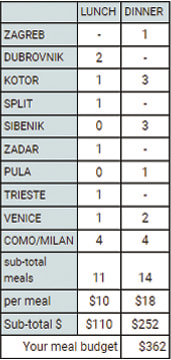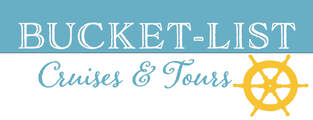 We are still getting questions for clarification so I'm posting the questions and the answers that Mark has given along with an article we have found most helpful. Don't hesitate to ask if you need clarification. Questions From Brent Olsen: Hi. I just read your info on money and have a question. I don’t know the geography well enough to know how to divide the money needed between euros and kunas. How many meals am I responsible for in Croatia? Also, you say you are bringing about $400 in cash and will rely on atms. What do you do with the US money? Can you spend it? What good is it? Mark's Response: Hello Brent, Some answers: 1. "geography... between euros and kunas." Kunas are only for Croatia...Dubrovnik to Pula. Every place else takes Euros. 2. How many meals am I responsible for in Croatia? I'm covering all of the tips except $50 aboard the ship. Dollars are fine there. We also cover all breakfasts for the whole trip, and 3 meals a day on the ship for 7 days. We are also picking up the lunch on the boat in Kotor, lunch on the boat to Krka and in Senj on the way to Pula. Here are the meals you need to cover in the chart to the left. We've recommended only bringing about $200 per person and a good Debit Card with a pin after having told your Debit Card company what you'll be doing. Exchanging your dollars brought from home is a problem for at least 3 reasons: 1. Changing dollars into Euros at Cambio or money exchange places can cost you 15%. 2. Vendors often accept $$$ but they have an even worse exchange rate. 3. European Banks are a bit better but still not the best solution. The best solutions are: 1. Paying for something with your credit card. Best exchange rates. 2. Getting euros or Kunas from the ATM. Fair warning: Debit Cards with a pin are best. Cash advances on credit cards add tough fees. BUT: To use your Debit Card talk to your bank and make sure they know where you're going and that you're using ATM's so PLEASE, Mr./Mrs. Banker, "Don't freeze my account when you see I'm using my Debit Card!" Questions from the Kittelsons with answers from Mark: 1. Do we pay tips in USD or local currency? We are covering the tips for the bus drivers, guides, park rangers, and most of the tips on the yacht. It's such a hassle for our guests to keep reaching in for some kind of a tip in whatever currency du jour, so we traded doing the tips for you covering some of the meals. In the blog it details those. You come out ahead and less hassle. But, tips are fine in Euros or dollars or kunas in Croatia although they prefer kunas so they don't have to exchange money. In Montenegro, Greece and Athens they prefer Euros. 2. Do we pay for tours by credit card or USD or local currency? The extra tours are mainly on the free day in Kotor and you can use Euros and often credit cards. Credit cards usually give you the best exchange rates. 3. Will we likely be paying for meals in USD, credit card, or local currency? Again see the blog for more details, but as a general rule, Euros are the easiest. ATMs in all countries except Croatia dispense money in Euros. In Croatia it's kunas. Some restaurants take credit cards, but don't count on it - you're safer with kunas in Croatia and Euros elsewhere. We advise against getting Euros in the USA as the exchange rate is less favorable. Usually ATMs are the best choice. If you're using a DEBIT CARD, make sure your bank knows you're going to Croatia, etc., and the time period or they may see an international charge and freeze the DEBIT CARD. Also make sure you have a pin for your debit card. Don't hesitate to ask me anything. Glad to help and I hope this was useful. Mark Here's a good article on using ATM's abroad: TRAVEL TIPS HOLIDAY MONEY Using ATMs abroad: How to avoid unfair exchange rates and hidden fees Wise Online Financial Travel Magazine 5 minute read Many seasoned travelers have discovered that the quickest and often cheapest way to get cash while traveling abroad is directly from an ATM. Airport exchange bureaus know you have nowhere else to go, so their fees can often be quite high. Other exchange options vary in quality and convenience. Even your bank will likely subject you to punishing hidden fees in their exchange rates. So it’s good news that finding the best exchange rate can be as easy as finding an ATM. All cash withdrawals, no matter their size, are exchanged based on the wholesale - the real - exchange rate of the day. If you’re not careful though, you can pay fees that will cancel out any savings. Here are a few things you should be aware of. Different types of foreign ATM fees Most bank ATMs charge fees. In some cases, these fees are only charged if you aren’t a member of that particular bank. To help avoid these fees, check what foreign banks your local bank partners with. Some ATMs, however, charge all users. Do your homework on the four various fees charged, and your pocketbook will thank you later. Fee 1: An International or transaction ATM fee This fee is added when you use a foreign ATM. Many banks charge higher fees for international withdrawals. You’ll either pay a flat rate (between £1-5 or $1-5) or a percentage of your total withdrawal (generally between 1-3%). Fee 2: A conversion charge These days most larger banks add an additional ‘conversion fee’ of between 1-3% of the transaction. It’s an unfortunate hidden surcharge that banks often charge for foreign ATM withdrawals. These fees are most common from American, British and Australian banks. Which means it’s likely that you’ll pay a combined flat fee for using an ATM network, plus a percentage of the value of the withdrawn cash. Fee 3: A surcharge A surcharge is added by the ATM as a fee for using the machine. The good news is you’ll be notified on the ATM screen and it will ask your permission to proceed with the transaction. Your best chance of avoiding this might be to use ATMs at major banks or post offices. Smaller banks and independently owned ATMs mean a higher risk of surcharges. Fee 4: Poor ATM exchange rates ATM exchange rates are all tied to the interbank currency rates traded on the global financial market. The rates constantly fluctuate, but will likely hover around the same figure for months at a time. With a quick Google search, you can find out what the current exchange rate is. Or just use an online currency converter to find out how much your money’s worth. That way, when you run across an ATM, you can decide for yourself whether the ATM is providing a fair exchange rate. You’d be surprised how many sneak in fees by offering a less than optimal amount. ATM Networks Your card is probably linked to over a million ATMs globally through a financial computer system. This is known as an interbank network. Through the network, you can conduct similar transactions at any ATM inside the network. For example, the Cirrus network owns Mastercard, Maestro, and Cirrus. If you see one or more of those three logos on an ATM, that means it’s a part of the Cirrus network. Not only that, but each network has an online ATM locator so you can find the nearest in advance. PLUS Network (Visa) The PLUS system is an interbank network that covers all Visa cards. They’re located in 200 countries and territories around the world. PLUS is the local network most common in the United States and is also used in Canada. You’re also likely to find PLUS ATMs in India and Indonesia, where many interbank networks have a presence. Find the nearest one by using the PLUS/Visa ATM locator online. Cirrus Network (MasterCard and Maestro) Cirrus is an interbank network operated by MasterCard found in 93 countries. It links MasterCard, Maestro, Diners Club cards to its network. The network is frequently found in the United States, Canada, Venezuela, Chile, and Saudi Arabia. In India and Bangladesh, the Cirrus network serves as both a local and international interbank network.Use their online locator to find Cirrus ATMs. Maestro Network (Mastercard and Maestro) Maestro is a multi-national debit card service that is also operated by MasterCard. Within Europe, Maestro is MasterCard’s main debit brand. By default, Maestro cards are linked to the Cirrus network, but often you’ll still find the logo on ATMs. Search for your nearest Maestro/Mastercard ATM. STAR Network STAR is an interbank network in the United States. It’s the largest American interbank network, servicing 2 million ATMs and more than 5,700 banks and financial institutions. STAR has their own ATM locator online. NYCE Network The New York Currency Exchange (NYCE) connects the ATMs of various financial institutions in Canada and the United States. You’ll find their machines mostly in the Midwest and Northeast. Search for NYCE ATMs online. Reducing your hidden ATM fees 1. Withdraw carefully While it’s never a good idea to travel with loads of cash on hand, you can avoid frequent ATM fees by withdrawing large amounts of cash at one time. Try to map out a rough budget in advance. Planning your withdrawals will mean you don’t end up with a lot of spare cash at the end of your trip. 2. Find a low-fee card Some banks charge fewer fees than others. For example, HSBC has ATMs all over the world and only charges $2.50 per ATM transaction, even at non-HSBC ATMs. And Capital One doesn’t charge any withdrawal fees themselves, but the local bank will still likely charge you. With enough research, you can find cards that suit your travel needs; some are better than others. 3. Know that credit unions are your friend If you have access to one, credit unions and smaller banks tend to have lower international transaction fees. Their ATM fees tend to be solely a percentage of the withdrawn amount with no additional flat fee. That means if you’re only withdrawing a small amount, it may be worth it. Credit unions only charge currency conversion fees, and do not tend to include other types of fees. Now you have the facts. When you go abroad, skip the kiosk and head straight to an ATM. They’re always open for business, they’re everywhere, and they’re usually your most cost-effective option. Warmly, Mark J. Stoddard
1 Comment
Bob Sundstrom
8/7/2022 08:35:11 am
Good info. I have been an atm fan for some time.
Reply
Leave a Reply. |

 RSS Feed
RSS Feed